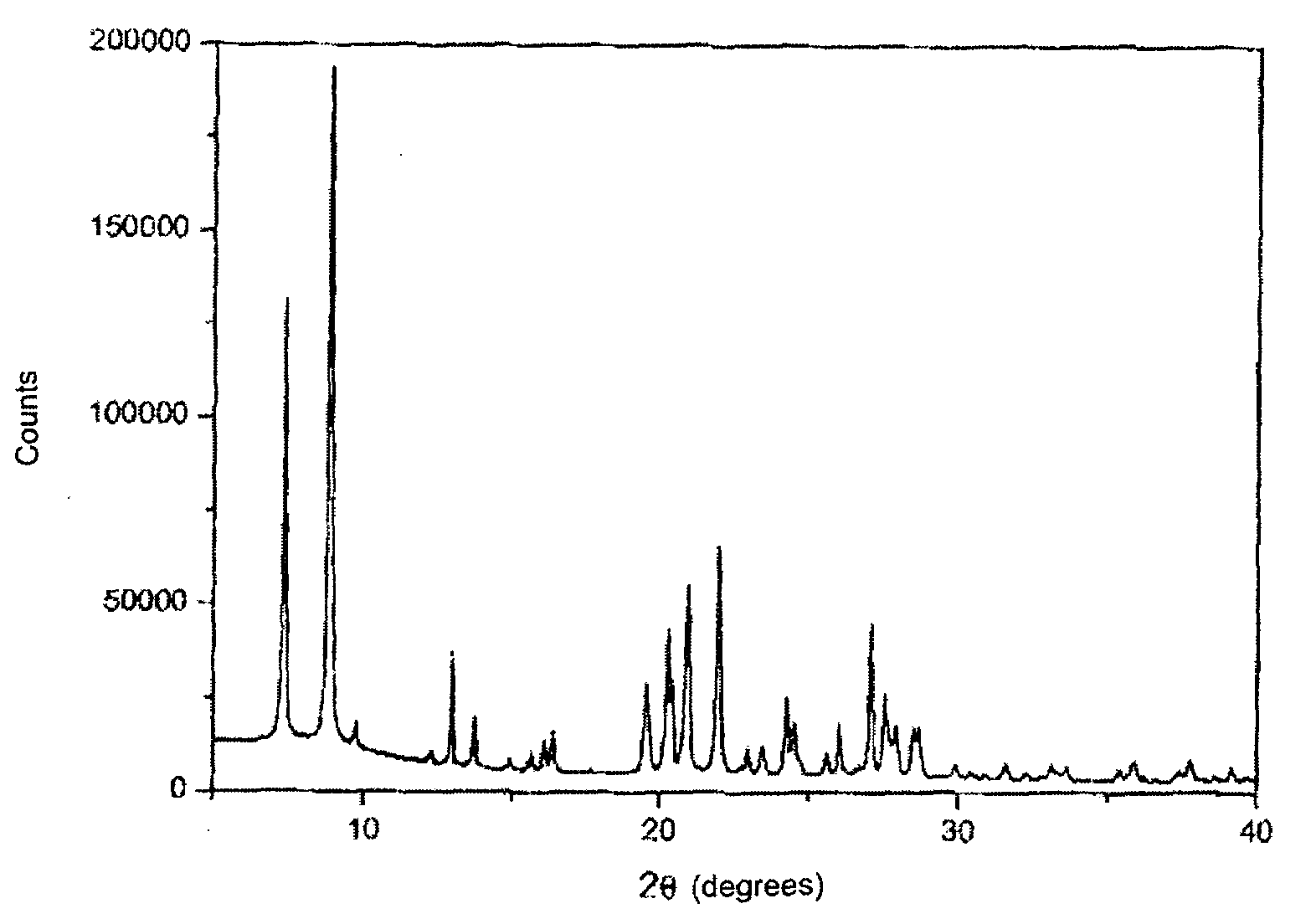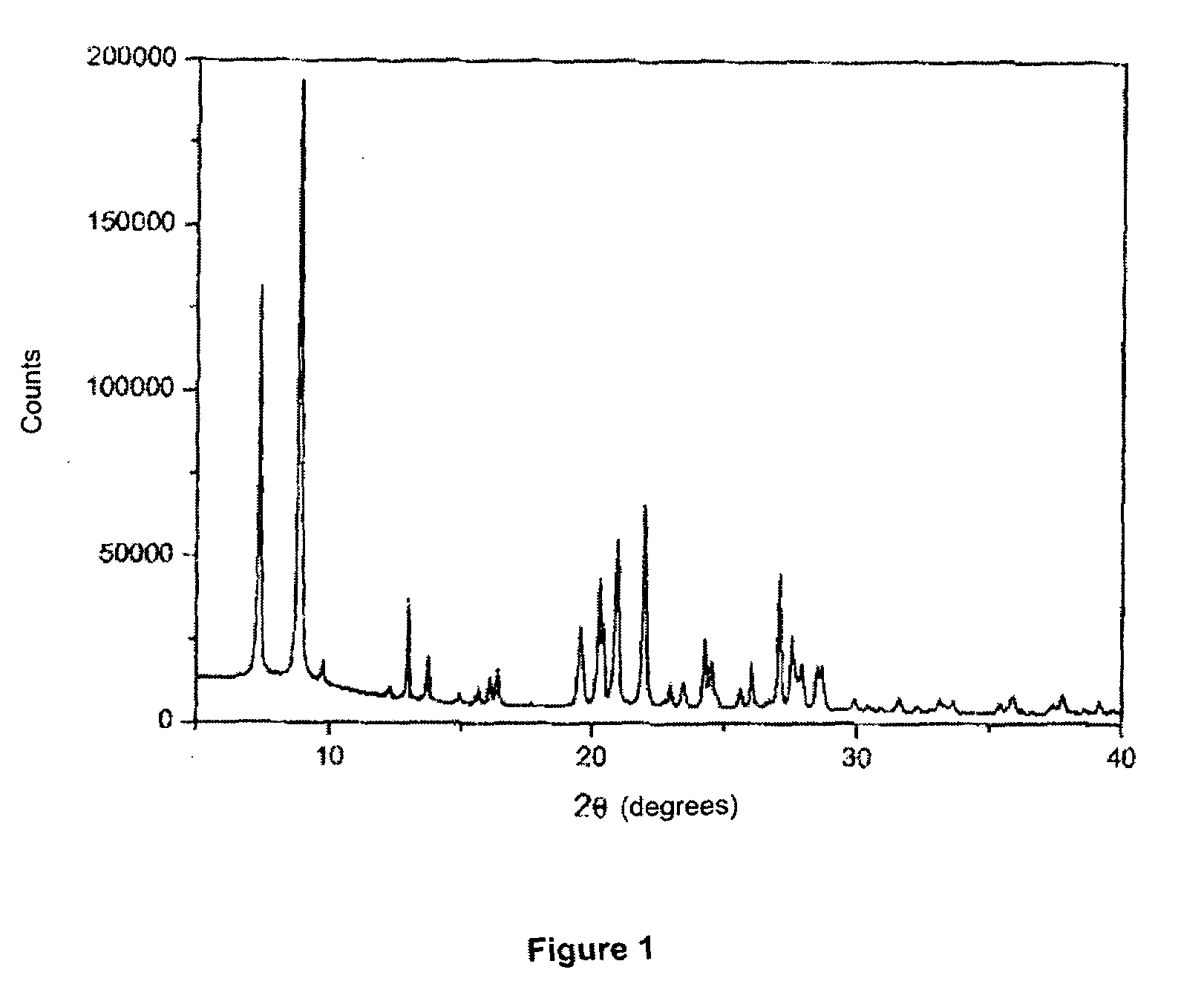Separation of Fluids Using Zeolite Itq-32
a technology of zeolite and fluid separation, which is applied in the direction of hydrocarbon purification/separation, water/sewage treatment by ion exchange, gaseous fuels, etc., can solve the problems of reducing the efficiency of separation process, and difficult purification of light olefins by distillation processes
- Summary
- Abstract
- Description
- Claims
- Application Information
AI Technical Summary
Benefits of technology
Problems solved by technology
Method used
Image
Examples
example 1
Preparation of the ITQ-32 Material of a T(IV) / T(III)=35
[0065]0.151 g Al isopropoxide is added onto 7.88 g tetraethylorthosilicate (TEOS). Next, 20.08 g of 4-cyclohexyl-1,1-dimethyl-piperazinium hydroxide (R′(OH)) solution which contains 1 hydroxide equivalent in 1000 g are added. The mixture is left evaporating while stirred up to complete elimination of the ethanol from the hydrolysis of the TEOS plus the amount of water necessary up to obtaining the final composition indicated. Lastly, 0.80 g of a fluorhydric acid (50% HF by weight) is added. The composition of the gel is:
[0066]SiO2: 0.01 Al2O3: 0.54 R′(OH): 0.54 HF: 7H2O
[0067]The mixture obtained is placed inside a polytetrafluorethylene-lined autoclave and is heated to 175° C. for 6 days in an oven equipped with a rotation system. The solid obtained on filtering, washing with distilled water and drying at 100° C. is ITQ-32.
example 2
Preparation of the ITQ-32 Material of a T(IV) / T(III)=260
[0068]7.86 g tetraethylorthosilicate (TEOS) is added onto 20 g of a 4-cyclohexyl-1,1-dimethyl-piperazinium hydroxide (R′(OH)) solution which contains 1 hydroxide equivalent in 1000 g. The mixture is left evaporating while stirred up to complete elimination of the ethanol from the hydrolysis of the TEOS plus the amount of water necessary up to obtaining the final composition indicated. Lastly, 0.80 g of a fluorhydric acid (50% HF by weight) and a suspension in water of 0.22 g ITQ-32 zeolite prepared exactly as described in Example 1 is added. The composition of the gel is:
[0069]SiO2: 0.00105 Al2O3: 0.54 R′(OH): 0.54 HF: 7H2O
[0070]Where the aluminum that is incorporated into the synthesis gel comes from the ITQ-32 zeolite employed as the seeding material. The mixture obtained is placed inside a polytetrafluorethylene-lined autoclave and is heated to 175° C. for 2 days in an oven equipped with a rotation system. The solid obtained...
example 3
Adsorption of Propene at 25° C. into the ITQ-32 Material of Example 2
[0071]The measurement of the propene adsorption capacity of the ITQ-32 material prepared according to Example 2, at 25° C. and 900 mbar corresponds to 5.5% by weight. Similarly, the value obtained after carrying out 20 adsorption / desorption cycles is of 5.3% by weight, which demonstrates that the ITQ-32 material retains its adsorption capacity indicating that oligomerization processes which block the pores of the zeolite do not take place.
PUM
| Property | Measurement | Unit |
|---|---|---|
| temperature | aaaaa | aaaaa |
| temperature | aaaaa | aaaaa |
| temperature | aaaaa | aaaaa |
Abstract
Description
Claims
Application Information
 Login to View More
Login to View More - R&D
- Intellectual Property
- Life Sciences
- Materials
- Tech Scout
- Unparalleled Data Quality
- Higher Quality Content
- 60% Fewer Hallucinations
Browse by: Latest US Patents, China's latest patents, Technical Efficacy Thesaurus, Application Domain, Technology Topic, Popular Technical Reports.
© 2025 PatSnap. All rights reserved.Legal|Privacy policy|Modern Slavery Act Transparency Statement|Sitemap|About US| Contact US: help@patsnap.com



